Photographing carnage: the award-winning Palestinian documenting Syria's war
Ahmed Deeb, a Palestinian from Gaza covering the Syrian conflict, spoke to The New Arab about the dangers he faces carrying out his work in Syria.
9 min read
Ahmed was injured while covering the Syrian conflict [photo provided]
Ahmed Deeb was born and raised in Gaza and has been working as a professional freelance photojournalist since 2008.
During his first year of work he received a number of awards and nominations , including the UNICEP photo of the year award and the UN Correspondents Association. Since 2012, he has covered the conflict in Syria, travelling to Aleppo, Idlib and Kobane.
The New Arab speaks to Ahmed about his work, the dangers he has faced, coming from Gaza to Aleppo, and the state of photojournalism in Syria and beyond.
During his first year of work he received a number of awards and nominations , including the UNICEP photo of the year award and the UN Correspondents Association. Since 2012, he has covered the conflict in Syria, travelling to Aleppo, Idlib and Kobane.
The New Arab speaks to Ahmed about his work, the dangers he has faced, coming from Gaza to Aleppo, and the state of photojournalism in Syria and beyond.
When and why did you become interested in photojournalism?
I grew up in Gaza and started working in photojournalism in 2008 - during the first war in Gaza.
During the war I lost eleven members of my family, including my uncle.
I owned a camera and at first didn’t take pictures in the war, but after a few days started documenting whats going on because this is a message I should send to the world, because its my country.
I saw a lot of children who have killed - for example in al-Shifa hospital - and many people dead. This gave me courage and motivation to document these things, so I started taking news pictures.
Before the war I was taking pictures of nature and every day life; the first camera I had was a gift from an uncle in Germany - a Nikon L10 I think - and I started contacting agencies - I started working and improving my skills until where I reached where I am today.
Palestinians have notorious difficulties with traveling - due to visas, and the closure of border crossings - did this ever effect you and your work?
I faced many obstacles regarding nationality so everywhere I need a visa - I covered the Egyptian revolution, Syria revolution and conflict, and conflict with Israel.
I had some assignments and opportunities, for example a photo exhibition in South Africa but I couldn’t go to because Rafah crossing was closed at that time. Another opportunity with “Risk organization” - it was training on how to keep safe deal with war zones - in the US - I couldn’t go to.
I lost so many opportunities because of my nationality and the closure of Rafah crossing.
You grew up in Sheikh Radwan neighbourhood in Gaza...to what extent did the environment there prepare you for the war in Syria?
Syria is not Gaza, its not like any other place - I couldn’t believe it was in so much of a bad situation.
Since covering this conflict for around three or four years, I feel it became my issue and case after Palestine - I’m very interested in the Syria conflict, I have friends there, I feel like I have loyalty to Syria also, like I belong there.
What kind of dangers have you faced covering the war in Syria?
I was injured in 2012 - I was covering the regime they wanted to take new positions from the opposition and at that time the rebels and the fighters.
The opposition had killed someone from the regime and they told me to come and cover what was going on. There was hole in the wall, we didn’t know there was sniper shooting. He kept shooting for around 10-15 minutes, and the wall was so thin, the bullets went through the wall.
In Gaza I’ve been beaten by Hamas police. To be journalist its not easy - its more dangerous than the fight of the fighters; you should be close enough to the people to take good pictures. When I went to Kobane I was beaten by the PYG [Kurdish People's Protection units].
I have had a lot of adventures in my life...I got some international awards - book called from Gaza to Aleppo - the similarities between Gaza and Syria.
Agencies and some national newspapers made the decision not to accept freelancers from Syria - what do you think about this decision and did this affect you?
I was with UPI when I started covering Syria, so at that time the foreign journalists were there, but after the rise of the Islamic state the foreign journalists stopped going to Syria and the agencies made a decision to stop accepting material from the country.
I contacted many agencies about the work and they told me they had a policy because we cannot afford the risk that you would face, and can’t guarantee that.
I don’t think the policy is a good thing because since the end of 2013 the coverage declined.
The citizen journalists in Syria don’t produce as good a quality, apart from some Syrian professionals....this is an injustice because this will skew the news coming from Syria.
They are not focusing so much on stories anymore. For example, if one hundred Syrians are killed, it will just be on breaking news, but no pictures....even the local photographers are suffering from this because there is less work...
They also need more protection such as flak jackets and helmets.

I’m against this policy [from agencies] and I hope they will rethink it and highlight the Syrian issue more because its very complicated.
The work of Syrian journalists is not enough and more focus is needed on the international community - many people don’t know whats going on in Syria - these agencies should help, they can deliver this message to Europe and effect on the public opinion, I’m working on this.
You cover intensive conflict environments as well as doing portraits - which do you prefer? photographing in the heat of the moment or telling individual stories?
I like to show people what they are doing in the war - I don’t go directly to film people and take photos of them; I listen to them, and talk to them so they trust me....its by chance if I get a good photo, without setting up the scene or telling them what to do.
I like covering the front lines, and the humanitarian side of the conflict - about how they are suffering and there is no water, no food and no income. I like telling people’s personal stories and what they have lost.
In Syria I did stories about the refugee camps....I like the children, and to be close to the children, and to listen to people and find the right story. Sometimes you need to write the right caption and description about the story.
I cover the front line and impact of the war on civilians, so I wanted as well to cover their stories...despite all of their difficulties they are still alive and refused to leave Syria.
These things touched me because I am from Gaza and I am a refugee - I know what being a refugee means, because when I see some Syrian children I see similarity between Palestinians and Syrians.
Do you ever find it difficult to separate yourself - emotionally and physically - from a particular scene and take a photo? Did you ever witness anything that you felt shouldn’t be photographed?
There is this question - ‘if you see someone injured should you help them or take a photo’ - and I will tell a story to answer this.
In 2012 there was shelling and shooting from the regime side - one sniper shot a guy and they put him in ambulance.
I took a photo of him when they were carrying him to the ambulance. I went inside the ambulance to take a photo, but there was only one medic and the guy was shot in the neck. The medic asked me to help....after all i didn’t have a choice, I should do my duty as a human not as a photographer.
But after I felt like his situation was stable and the medic didn’t need my help, I took photos.
Another time, the opposition executed 15 people from the regime side. I didn’t see the event but went afterwards, I stopped for a few minutes and i couldn’t take photos of that, it was so horrible - 15 dead people on the ground...its a bad image about the opposition, and they are not doing that all the time. And it would be against agency’s editorial politicies to take such images.
I witnessed much that is worse...people who are dying...I never gave up. This is my duty as a photographer, and as a Palestinian its easy for me to go into Syria. The people are so lovely and like Palestinians...they consider me as one of them. So although sometimes its hard being a Palestinian in the job, it also helps!
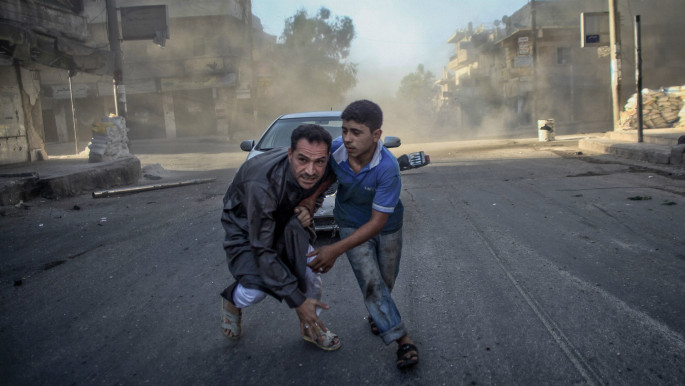
Similarly, there has been some debate on the boundaries of photojournalism....some said it was disrespectful to share the photo of Aylan. Others have said that some photos of refugees in camps violate their privacy. What do you think?
I don’t want people to feel they are victims of us as photographers, people can think of bad things about journalists in general - because of that I make a relationship with them - in conflict you don’t have choice.
Photography is not just a business...I don’t like people to suffer. I suffered as them...I put myself all the time in their shoes. I respect them....some people refuse to be pictured for security reasons, or family reasons...I respect all of these [choices].
I have my own ethics, I don’t care about journalism ethics, these are my own ethics, ethics of humanity.
Are there any photographs you especially remember, or remember taking?
For me there are some photos when I see them I remember the whole situation...it was crazy being in that situation.
For example, in Aleppo there was one man under the rubble. I thought he had passed away - but then some from the Civil Defense Team came and removed the dust and rubble out...then he opened his eyes...I was shocked.
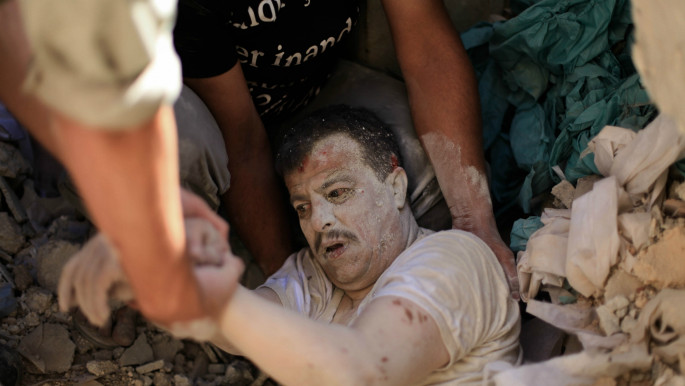
There is another photo I like from the refugee camps - one woman was washing her son in a wash-basin and the water was dirty. I liked that picture, because I was in that situation myself...it reminded me of refugee camps [in Gaza].
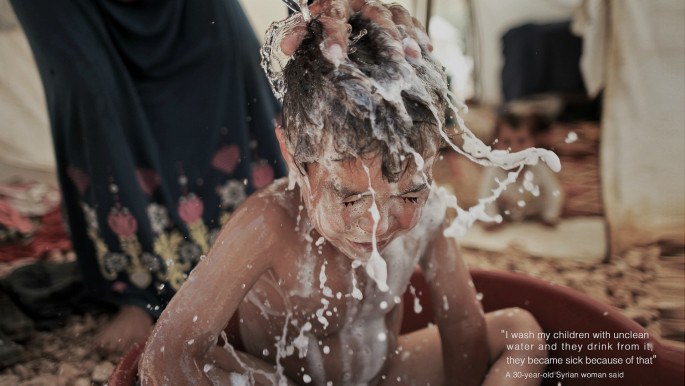
What do you think of the state of Arab photojournalism? Especially since the Arab spring, there have been many success stories...
Palestinian photographers have won international awards and have been sent to many conflict zones, and they know what war means. They have so much experience, as much as the foreign journalists.
The problem is with mobility; we have the same experience and skills as foreigners but the problem is we don’t have the opportunities and freedom of movement. For example, I wanted to cover immigration crisis in Greece and Europe.
We have so many photographers in the Arab community in Arab countries, they are very experienced and motivated but they don’t have the same opportunities.
Finally, what advice would you give to young aspiring photojournalists in Gaza?
I trained many people in Gaza who would like to become a photographer - we have so many in Gaza - but they don’t have the chance to publish their images; they just publish their photos on facebook and local media.
My advice is to work hard on skills and experience, look at work from great photographers, learn about the structure and composition of a photograph.
At the same time they have to learn English - this is very important to get in touch with international community to publish their photos.
They must work hard on themselves and listen to the advice of older and professional photographers and follow their work.
In any conflict zone, people carrying their weapons but the photographer is carrying their camera; the camera is our weapon.
All photographs the works of Ahmed Deeb, republished here with his kind permission.
I grew up in Gaza and started working in photojournalism in 2008 - during the first war in Gaza.
During the war I lost eleven members of my family, including my uncle.
I owned a camera and at first didn’t take pictures in the war, but after a few days started documenting whats going on because this is a message I should send to the world, because its my country.
I saw a lot of children who have killed - for example in al-Shifa hospital - and many people dead. This gave me courage and motivation to document these things, so I started taking news pictures.
Before the war I was taking pictures of nature and every day life; the first camera I had was a gift from an uncle in Germany - a Nikon L10 I think - and I started contacting agencies - I started working and improving my skills until where I reached where I am today.
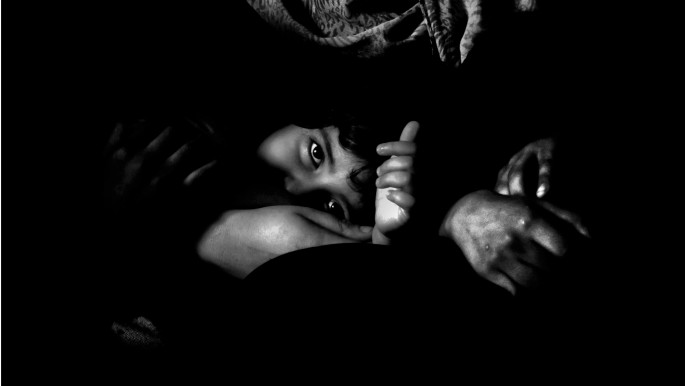 |
|
| A child in Gaza hides in her mother's lap during the last 2014 war [from Deeb's book - from Gaza to Aleppo] |
Palestinians have notorious difficulties with traveling - due to visas, and the closure of border crossings - did this ever effect you and your work?
I faced many obstacles regarding nationality so everywhere I need a visa - I covered the Egyptian revolution, Syria revolution and conflict, and conflict with Israel.
I had some assignments and opportunities, for example a photo exhibition in South Africa but I couldn’t go to because Rafah crossing was closed at that time. Another opportunity with “Risk organization” - it was training on how to keep safe deal with war zones - in the US - I couldn’t go to.
I lost so many opportunities because of my nationality and the closure of Rafah crossing.
You grew up in Sheikh Radwan neighbourhood in Gaza...to what extent did the environment there prepare you for the war in Syria?
Syria is not Gaza, its not like any other place - I couldn’t believe it was in so much of a bad situation.
Since covering this conflict for around three or four years, I feel it became my issue and case after Palestine - I’m very interested in the Syria conflict, I have friends there, I feel like I have loyalty to Syria also, like I belong there.
 |
|
| A Syrian refugee girl in Idlib [From Deeb's book - from Gaza to Aleppo] |
What kind of dangers have you faced covering the war in Syria?
I was injured in 2012 - I was covering the regime they wanted to take new positions from the opposition and at that time the rebels and the fighters.
The opposition had killed someone from the regime and they told me to come and cover what was going on. There was hole in the wall, we didn’t know there was sniper shooting. He kept shooting for around 10-15 minutes, and the wall was so thin, the bullets went through the wall.
In Gaza I’ve been beaten by Hamas police. To be journalist its not easy - its more dangerous than the fight of the fighters; you should be close enough to the people to take good pictures. When I went to Kobane I was beaten by the PYG [Kurdish People's Protection units].
I have had a lot of adventures in my life...I got some international awards - book called from Gaza to Aleppo - the similarities between Gaza and Syria.
Agencies and some national newspapers made the decision not to accept freelancers from Syria - what do you think about this decision and did this affect you?
I was with UPI when I started covering Syria, so at that time the foreign journalists were there, but after the rise of the Islamic state the foreign journalists stopped going to Syria and the agencies made a decision to stop accepting material from the country.
I contacted many agencies about the work and they told me they had a policy because we cannot afford the risk that you would face, and can’t guarantee that.
I don’t think the policy is a good thing because since the end of 2013 the coverage declined.
The citizen journalists in Syria don’t produce as good a quality, apart from some Syrian professionals....this is an injustice because this will skew the news coming from Syria.
They are not focusing so much on stories anymore. For example, if one hundred Syrians are killed, it will just be on breaking news, but no pictures....even the local photographers are suffering from this because there is less work...
They also need more protection such as flak jackets and helmets.

I’m against this policy [from agencies] and I hope they will rethink it and highlight the Syrian issue more because its very complicated.
The work of Syrian journalists is not enough and more focus is needed on the international community - many people don’t know whats going on in Syria - these agencies should help, they can deliver this message to Europe and effect on the public opinion, I’m working on this.
You cover intensive conflict environments as well as doing portraits - which do you prefer? photographing in the heat of the moment or telling individual stories?
I like to show people what they are doing in the war - I don’t go directly to film people and take photos of them; I listen to them, and talk to them so they trust me....its by chance if I get a good photo, without setting up the scene or telling them what to do.
I like covering the front lines, and the humanitarian side of the conflict - about how they are suffering and there is no water, no food and no income. I like telling people’s personal stories and what they have lost.
In Syria I did stories about the refugee camps....I like the children, and to be close to the children, and to listen to people and find the right story. Sometimes you need to write the right caption and description about the story.
 |
|
I cover the front line and impact of the war on civilians, so I wanted as well to cover their stories...despite all of their difficulties they are still alive and refused to leave Syria.
These things touched me because I am from Gaza and I am a refugee - I know what being a refugee means, because when I see some Syrian children I see similarity between Palestinians and Syrians.
Do you ever find it difficult to separate yourself - emotionally and physically - from a particular scene and take a photo? Did you ever witness anything that you felt shouldn’t be photographed?
There is this question - ‘if you see someone injured should you help them or take a photo’ - and I will tell a story to answer this.
In 2012 there was shelling and shooting from the regime side - one sniper shot a guy and they put him in ambulance.
I took a photo of him when they were carrying him to the ambulance. I went inside the ambulance to take a photo, but there was only one medic and the guy was shot in the neck. The medic asked me to help....after all i didn’t have a choice, I should do my duty as a human not as a photographer.
But after I felt like his situation was stable and the medic didn’t need my help, I took photos.
Another time, the opposition executed 15 people from the regime side. I didn’t see the event but went afterwards, I stopped for a few minutes and i couldn’t take photos of that, it was so horrible - 15 dead people on the ground...its a bad image about the opposition, and they are not doing that all the time. And it would be against agency’s editorial politicies to take such images.
I witnessed much that is worse...people who are dying...I never gave up. This is my duty as a photographer, and as a Palestinian its easy for me to go into Syria. The people are so lovely and like Palestinians...they consider me as one of them. So although sometimes its hard being a Palestinian in the job, it also helps!

Similarly, there has been some debate on the boundaries of photojournalism....some said it was disrespectful to share the photo of Aylan. Others have said that some photos of refugees in camps violate their privacy. What do you think?
I don’t want people to feel they are victims of us as photographers, people can think of bad things about journalists in general - because of that I make a relationship with them - in conflict you don’t have choice.
Photography is not just a business...I don’t like people to suffer. I suffered as them...I put myself all the time in their shoes. I respect them....some people refuse to be pictured for security reasons, or family reasons...I respect all of these [choices].
I have my own ethics, I don’t care about journalism ethics, these are my own ethics, ethics of humanity.
Are there any photographs you especially remember, or remember taking?
For me there are some photos when I see them I remember the whole situation...it was crazy being in that situation.
For example, in Aleppo there was one man under the rubble. I thought he had passed away - but then some from the Civil Defense Team came and removed the dust and rubble out...then he opened his eyes...I was shocked.

There is another photo I like from the refugee camps - one woman was washing her son in a wash-basin and the water was dirty. I liked that picture, because I was in that situation myself...it reminded me of refugee camps [in Gaza].

What do you think of the state of Arab photojournalism? Especially since the Arab spring, there have been many success stories...
Palestinian photographers have won international awards and have been sent to many conflict zones, and they know what war means. They have so much experience, as much as the foreign journalists.
The problem is with mobility; we have the same experience and skills as foreigners but the problem is we don’t have the opportunities and freedom of movement. For example, I wanted to cover immigration crisis in Greece and Europe.
We have so many photographers in the Arab community in Arab countries, they are very experienced and motivated but they don’t have the same opportunities.
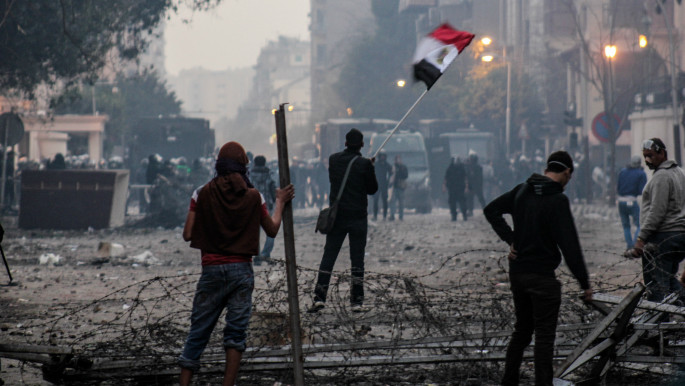 |
|
Finally, what advice would you give to young aspiring photojournalists in Gaza?
I trained many people in Gaza who would like to become a photographer - we have so many in Gaza - but they don’t have the chance to publish their images; they just publish their photos on facebook and local media.
My advice is to work hard on skills and experience, look at work from great photographers, learn about the structure and composition of a photograph.
At the same time they have to learn English - this is very important to get in touch with international community to publish their photos.
They must work hard on themselves and listen to the advice of older and professional photographers and follow their work.
In any conflict zone, people carrying their weapons but the photographer is carrying their camera; the camera is our weapon.
All photographs the works of Ahmed Deeb, republished here with his kind permission.





 Follow the Middle East's top stories in English at The New Arab on Google News
Follow the Middle East's top stories in English at The New Arab on Google News


